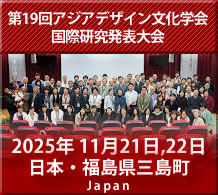Asian Design Culture Society
 ― in pursuit of designing a full living for the 21st century ―
― in pursuit of designing a full living for the 21st century ―
In Asia, even as the monsoon climate has created diverse cultures among countries and even among regions in each of these countries, these places share common features.
These similarities can be identified through the accumulated knowledge and experiences handed down from generation to generation as humankind pursue the achievement of productive societies and thriving communities. People often question themselves: “Where do we come from? What are we? Where are we going?” Such scrutiny implies that people should know their past in order to understand what exists—the positive—and to reflect on the future—the normative.
This is essentially the guiding principle of designing a living, which is reflected in the Japanese design concept of jinshin no hana or the flowering of the total person. Societies should be guided by this concept as they aim for an optimum utilization of precious resources while at the same time fully respecting
local identity.
Another characteristic shared by Asian communities is the belief in the concepts of moushiwakenai and mottainai which both connote apology or remorse for wasting natural resources. Believers try to coexist equally with nature where, they believe, spirits reside.
They care for a neighborhood’s natural environment and respect the total locality. The knowledge and experiences gained from a symbiotic relationship—not a managed coexistence—with nature are the people’s fundamental tools in creating a flourishing society. This approach essentially differs from that which espouses the idea of controlling nature as if it is the weaker
party.
The latter idea is being largely accepted in the process of advancing the universality of values through the overwhelming wave of globalization. With the recognition of these different value systems, designers should pursue one definite direction in designing a living for the future.
The newly coined word “glocal,” which encapsulates the concepts of globalization and localization, indicates the possibility of spreading practical meaning to designing a living for the 21st century.
The number of professionals who understand and practice this design concept is growing. They are designers, researchers, educators, and other practitioners who apply shared knowledge and experiences. Their roles and work arenas are steadily expanding even as the educational environment to develop young disciples is rapidly improving.
Against this background, it would be timely and of great significance to create a common meeting ground, an academic society where professional groups sharing the above-mentioned principle and objectives can work together.
During this event, therefore, we are launching the Asian Design Culture Society whose mission is to effectively share its members’ individual knowledge and experiences in designing a living through cultural, personal, and academic exchanges and collectively bring about the genuine flowering of—and in—our Asian
and, moreover, world communities.


